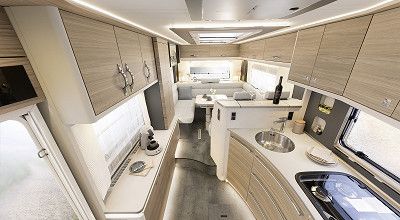If you are thinking about hiring or buying a motorhome, the first question is whether it should be semi-integrated or integrated. But what is really the difference? Freeontour presents the most important features of fully integrated motorhomes here.
The integrated motorhomes - also known as A class motorhomes - are generally the flagships in a manufacturer’s motorhome fleet: The main customers for these six- to over nine-metre long motorhomes are often campers who enjoy spending a lot of time in their vehicles or want to spend the entire winter season in warm southern regions. Accordingly, they appreciate the larger amount of space available in an integrated motorhome, compared with a comparable semi-integrated model.
What is the difference between an integrated motorhome and a semi-integrated motorhome?
The prominent feature of integrated motorhomes when compared with semi-integrated motorhomes and alcove motorhomes is – as suggested by the name – the conceptual integration of the cab into the set up: The cab covers the whole width of the living area, while the high roof offers headroom and storage space. Externally, the body work appears to be one piece, and when viewed from the front and the sides it looks almost like a compact bus. Naturally, the construction and finishing of an integrated motorhome is somewhat more complicated: In a semi-integrated or low profile motorhome and alcove motorhome, the base is a chassis with a separate standard cab.
In an integrated or A class motorhome, the base is a chassis cowl, in other words a stripped down frame with an open cab platform, including the instrument panelling, consoles and controls. The complete body is then mounted onto this, which can be composed of either one or more wall components, depending on the motorhome manufacturer’s concept. The front mask including the front side sections of a motorhome is normally a separate part, which is connected to the adjoining walls of the body work at the respective crossover points. By adjustment of the instrument panelling to the cabin width of the motorhome and the inclusion of the cab in the living area behind, the cab area becomes integrated, as its name says.
The main argument in favour of an A class motorhome:
More (perceived) space
The inclusion of the cab in the living area is ultimately the overwhelming reason for many campers who decide to buy an A class motorhome. Because, compared with the other designs, the panoramic view enhances the travelling experience for the driver and passenger, and the transition into the living area behind offers a generous feeling of space. The layouts of the integrated motorhomes do not differ considerably from the semi-integrated and alcove motorhomes. The integrated cab with the swivel seats are incorporated into the living area with the seats and overhead cupboards, a kitchen, a bathroom, and a bedroom at the rear with either a double bed or two single beds.
These days, the majority of the large integrated motorhomes have saloon bathroom variants. This means the two areas, the shower cubicle and washbasin/toilet area, are separated by a connecting door, so they can also be used as a private dressing room. However, spacious swivel bath variants are also becoming increasingly popular.
Occasionally a drop-down bed over the living area is available as standard in the motorhome, but generally it has to be ordered separately. This option is generally appreciated as an additional sleeping arrangement by grandparents who like to travel regularly with their grandchildren, or couples who occasionally like to travel with friends. In any case, an electric raising/lowering mechanism is definitely preferable to a manual one, as it means you don’t have to constantly heave the bed up and down.
What is the average size of an integrated motorhome?
As with all the motorhome types, if you are looking to hire or buy an integrated motorhome you should ask yourself: How much space do I need and what do I want to take with me on my trip? The available A class motorhomes range from 6.0 m to nearly 9.40 m total length in Europe (ignoring the over 10 m Liner on a lorry base with over 7.5 t maximum weight allowed). The easiest format to handle has been shown to be the A class motorhomes up to 8 m length, with a height of between 2.70 and 2.90 m, and a width of maximum 2.35 m.
The permissible total weight is between 3.5 and up to 7.49 t. For most couples a 3.5 t machine is often sufficient - unless they want to take two Pedelecs (electric bikes) or a motor scooter with them on holiday. If you want to buy a new motorhome, you should also consider the weight of any additional equipment during the weight calculation. Because this increases the “mass of the vehicle in running order” and therefore reduces the possible load.













